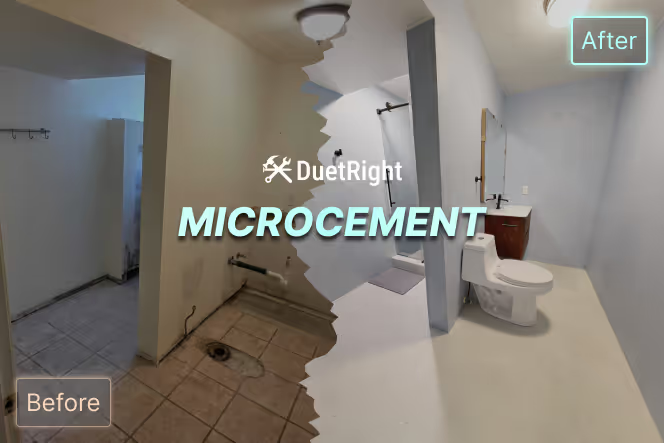Can You Renovate a Bathroom For Under $10k In Seattle?
You CAN renovate a bathroom for $10,000—but you’ve got to be smart about it.

If you've started pricing out bathroom renovations in Seattle, you're probably wondering how something so small can cost so much. You Google a few quotes, see numbers like $25,000 or more, and suddenly that worn-out vanity and oldie moldie tub doesn’t seem so bad.
But here's the good news: if you're not moving plumbing and your layout still works, you don't necessarily need a full remodel. A focused, surface-level renovation can still give your bathroom a fresh new look.
And if you plan it right, you can pull it off for under $10,000.
That’s what this quick guide is for. I’ll show you what that kind of budget actually covers in Seattle, how to make smart upgrade choices, and what to skip if you want to avoid overspending.
Let's dive in!
Remodel vs. Renovation—Know the Difference
This part gets glossed over a lot, but it's key.
A remodel changes the structure. You’re moving walls, rearranging plumbing, maybe expanding the room. It’s a bigger deal, and in the Emerald City, it’s where costs explode—think $25k to $45k, minimum.
A renovation keeps the bones of the room intact. You're upgrading what’s already there: new tile, a better vanity, modern fixtures, fresh paint. No plumbing reroutes. No permits for structural changes.
And that’s the lane we’re staying in to keep costs at around 10 grand.
So if your bathroom’s ugly but functional, a renovation is exactly what you need to make an upgrade without breaking the bank.
How to Plan a Bathroom Refresh That Doesn’t Blow the Budget
Instead of breaking the budget into rigid options, here’s 5 steps to actually make the most of a $10,000 renovation in the Emerald City:
1. Start With the Surfaces That Matter Most
In most bathrooms, the floors and the tub or shower surround dominate the space—and your budget. Tiling is often the most expensive part of a renovation, especially when it involves demolition and professional installation. But it's also one of the most impactful upgrades you can make.
If your existing tile is intact and you’re not dealing with water damage, refinishing (also called reglazing) the tub and surrounding tile can give the space a clean, like-new look for far less Moolah. Just be careful—if there are signs of mold, refinishing isn’t a safe option. Mold behind tile can be hazardous to your health and needs to be professionally addressed before moving forward with cosmetic changes.
So what do the costs look like depending on your route?
- Floor tile demo + install: ~$3,000
- Tub surround reglazing (no demo or new tile): ~$600
- Full tub surround tile demo + install (new tile): ~$4,000–$7,000
If your budget is tight, reglazing can buy you a few more years before you invest in full demo. But if the tile’s outdated or failing—or if there’s moisture damage underneath—it’s worth budgeting for a full tile surround replacement. Just be aware that once demo begins, hidden issues like mold or rotten framing can add cost. When in doubt, get a pro to assess before you decide.
2. Choose the Perfect Vanity
Vanities are one of the most visible features in your bathroom, and upgrading them can instantly modernize the space. The trick here is to balance cost with style and function.
You don’t need a custom-built piece to get a beautiful result. Stock vanities from places like Home Depot or Wayfair often come with an integrated sink and can look surprisingly high-end for the price (many solid single-sink options are available for $650 or less).
Just be sure to measure your space carefully. An awkward fit can throw off the whole room and make installation harder.
Double vanities, on the other hand, can more than double your cost. It's possible, however, to find a deal during a big sale if you're lucky (up to 40% off in some cases), but outside of promotions, plan for $1,200–$1,500 or more once you factor in the added plumbing.
Here are your typical costs when it comes to getting a new vanity:
- Single-sink stock vanity with top: ~$650
- Mid-range faucet: ~$150
- Plumbing labor (install sink and faucet): ~$300
This is one place where it pays to be strategic. Spending just a little more on a clean, modern vanity can upgrade the look and feel of the room without blowing your budget.
3. Don’t Skip Lighting and Mirrors
It’s easy to overlook lighting and mirrors, but they’re two of the most noticeable features in a bathroom. They’re also among the most cost-effective ways to make the space feel more modern, bright, and cohesive.
Swapping in a clean-lined LED mirror or framed medicine cabinet can instantly upgrade the wall above the vanity. Pair that with a new light fixture (something in brushed nickel or matte black, for example) and the whole space feels refreshed.
These small touches can really go a long way.
And since lighting is such a visual focal point, it’s often one of the first things guests notice. You can expect to spend at least the following estimates on lighting and mirrors.
- Vanity mirror or medicine cabinet: ~$100–$250
- Light fixture: ~$100–$200
- Installation (basic electrical): ~$200
If you’re keeping your layout the same, updating these features is usually a quick job for an electrician. And if you’re handy, swapping a fixture or hanging a mirror can be a straightforward DIY win that saves even more.
4. Save Your Paint Job for Last
A fresh new coat of paint can be one of the best visual upgrades for the price. It should always come after other messy work, though, like tile installation, vanity swaps, or any drywall patching so that you’re not redoing things twice.
A clean coat of paint on the walls and ceiling makes everything else look finished. Soft whites, warm neutrals, or muted blues are popular choices that help reflect light and make a small bathroom feel more spacious.
Typical costs are as follows.
- Paint + supplies (DIY): ~$100–$200
- Professional painting: ~$600–$800
If you’re trying to stretch your $10K budget, this is one of the easiest areas to save money. With a weekend and some painter’s tape, even beginners can get good results—and it's a suprisingly satisfying project to tackle with your partner.
5. Know When to Call a Pro
Some parts of a bathroom renovation simply just require a pro, especially anything that involves water or wiring. A bad plumbing job can cause leaks inside your walls (you can imagine how much that costs). Electrical mistakes? Way worse.
Stick to pros for the risky stuff:
- Plumbing hookups for sinks and toilets
- Light fixture wiring
- Any work behind the walls (especially if you’re opening them up)
In Seattle, plumbing and electrical work often requires a permit—especially if you’re changing or adding connections. Cutting corners here might save a few bucks today but cost you thousands later if something goes wrong.
In terms of the labor costs, expect somewhere in the ballpark below:
- Plumbing labor: ~$300–$600 per fixture
- Electrical labor: ~$200–$500 per light or fan
Our mantra is this: don’t overpay for simple stuff, but don’t risk major damage either.
If it’s beyond your skill set or safety is involved, let a licensed contractor handle it.
Sample Renovation: What $10K Covers in Seattle
I won't sugarcoat things here. Seattle isn’t the easiest place to stretch a renovation budget. Labor’s expensive. Materials cost more than they used to. And thanks to tariffs on building supplies, prices have climbed even higher recently.
Still, with the right plan, $10,000 goes further than you'd expect, assuming you're renovating a small full bathroom, guest bathroom, or three-quarter bath (something around 5' x 7' with a single vanity and a tub/shower combo).
This scope of work assumes you're keeping the layout the same, avoiding plumbing or electrical relocation, and opting for surface upgrades only.
- Tub surround reglazing (no demo or new tile): ~$600
- Floor tile demo and install (standard ceramic): ~$4,000
- Stock single-sink vanity with integrated top: ~$650
- Mid-range faucet and basic plumbing install for vanity: ~$250
- Standard toilet installation (fixture + labor): ~$450
- Simple mirror and light fixture combo: ~$300
- Painting of walls and ceiling (hired): ~$700
- Trim and baseboards replacement: ~$300
- Basic labor for plumbing, light electrical, and finish work: ~$1,000
Total Estimated Cost: ~$8,250–$9,250
This leaves just enough room in the budget (~$750–$1,750) for:
- Debris removal and light cleanup
- Small accessories (towel bars, shelves)
- A basic contingency buffer in case something small comes up
What About Master Bathrooms?
Renovating a full master bath for under $10K is wild... but anything's possible!
Master bathrooms are quite large and may include:
- A double vanity
- Separate tub and shower
- More square footage
- Additional lighting or outlets
For a $10K master bathroom renovation, here’s what you’d need to do:
- Skip tiling the shower and opt for reglazing or acrylic panels
- Choose a sale-priced double vanity (~$900–$1,200 range)
- Use basic finishes
- Possibly DIY the painting and some finish work
- Avoid moving plumbing or electrical
Even then, it would be tight. Most Seattle-area master bath renovations range from $15,000 to $30,000 depending on the scope.
🎯 For homeowners with master bath ambitions on a smaller budget, we recommend either phasing the project over time or focusing first on the most-used half of the bathroom (like the vanity and flooring), then tackling the shower or tub later.
Still, whether you’re renovating a guest bath or tackling a larger space in phases, the outcome depends heavily on who you hire to do the work and how the project gets managed.
Franchise vs. Local Contractor: Speed vs. Quality
You’ve probably seen the ads from companies like Bath Planet, Re-Bath, or Bath Fitter offering “one-day” installs that promise a clean, fast bathroom transformation. Sure, the speed sounds appealing, especially if all you’re after is a quick shower liner or some wall panels to cover old tile.
But that speed comes at a price—and not just the final bill.
These franchise companies often cut corners to meet tight timelines. They use thin acrylic materials and prefab parts that get installed over your existing surfaces. Think of it as a patch instead of a true upgrade.
You’re not getting custom tile work, premium materials, or craftsmanship that’s built to last. In fact, many of these “quick fix” jobs start to show issues within a year or two: cracked panels, failed caulking, poor waterproofing. All for a price that’s often $10K to $18K or more.
Don’t just take our word for it... check out their Google reviews. You’ll find story after story about rushed installs, disappointing results, and customer service that disappears once the job is done.
If you care about quality, if you want a bathroom that still looks good five years from now, and if you want to choose your own finishes, then you’re better off working with a local contractor. Someone who can help you phase the work, customize the design, and deliver results that feel intentional, not templated.
Plus, it just feels good to support small businesses in your community, wouldn't you agree?
If you’re keeping things cosmetic and within budget, that local route almost always gives you the most value for every dollar you spend. It’s how you get the job done once and done right.
Ready to Renovate Without Overspending?
If your bathroom still has good bones but feels outdated, you don’t have to wait for a $30K remodel. A smart, surface-level renovation that's planned and installed by the right team can completely change how the space looks and feels.
Here at DuetRight, we help Seattle homeowners get the most out of their budget with honest guidance, practical solutions, and quality craftsmanship that lasts.
Don't be shy let’s talk through your options and see what makes sense for your space.
Explore Recent Posts

Reimagining a Kirkland Bathroom With Microcement

The Story of Tom's Queen Anne Condo Bathroom Remodel


